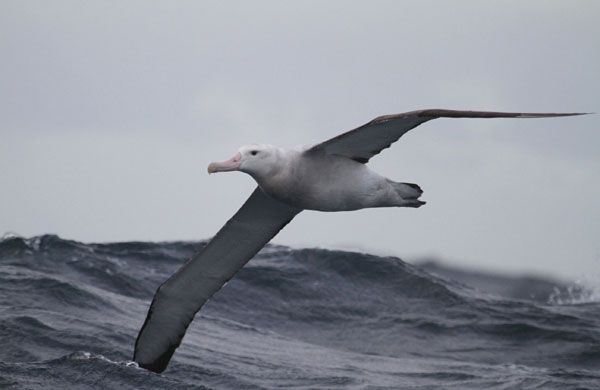Albatrosses Soar Easier on Change of Winds

Winds over the Southern Ocean, around the continent of Antarctica, have shifted and picked up in recent decades, giving a lift to foraging albatrosses, scientists say.
One species, the wandering albatross, can fly more than 2,175 miles (3,500 kilometers) looking for food, particularly dead squid floating on the ocean. During the summer, one breeding partner can travel for days or weeks at a time in search of food while the other incubates the egg.
Over the last two decades and possibly longer, changes in winds appear to have led to shorter, easier foraging trips, leading to heavier birds and more chicks for a population of wandering albatrosses on Possession Island, one of the Crozet Islands in the Southern Ocean, according to a study published in the Jan. 13 issue of the journal Science.
Winds of change
Over the past 50 years, summertime westerly winds over the mid-latitudes, within which Possession Island lies, have been shifting farther south, closer to the Pole, and strengthening.
The hole in the protective ozone layer — which has expanded above the Antarctic during recent decades but is expected to recover eventually — is primarily responsible. The ozone hole decreases temperatures above the Pole. This creates a more significant atmospheric pressure difference between the polar region and the tropics, resulting in a shift and strengthening of the westerly winds, according to Judith Perlwitz, a research scientist at the University of Colorado, Boulder, who was not involved in the study.
Global warming is expected to have a similar effect, but by warming the atmosphere over the tropics. But the ozone hole has been the dominant driver behind the changes in winds so far, according to Perlwitz.
Sign up for the Live Science daily newsletter now
Get the world’s most fascinating discoveries delivered straight to your inbox.
Flight of the albatross
Large seabirds and excellent gliders, the wandering albatross depends on the wind for its foraging trips, which have been recorded to last up to 35 days.
To take off, they fly into the wind to reach gliding altitude, then the birds turn, and fly with side or tail winds. From there, they can glide for 1,640 feet (500 meters) at a time, according to Henri Weimerskirch, a study researcher and head of a marine predator group at Centre d'Etudes Biologiques de Chizé in France.
Wind data from the vicinity of the Crozet Islands taken during the 1960s on shows a continuous increase in the north-to-south component of winds, as well as a shift poleward, over the past 50 years, a trend that also shows up in more recent satellite observations, according to Weimerskirch.
He and colleagues compared wind data to data collected from the albatross colony. Starting in 1966, researchers began recording the length of foraging trips, breeding success and body mass. Then in 1989 they began recording where the birds flew using satellite-tracking devices.
The satellite data showed the birds, particularly the smaller-bodied females, took advantage of the shift in the winds to forage farther south.
Travel speed for both sexes, which includes rest time on the surface of the water, increased, as did flight speed for females. This meant shorter foraging trips for everyone — a big benefit for the albatross population, because length of foraging trips has a direct effect on chick survival. If one parent is gone for too long, the remaining parent may desert the nest in search of its own food.
Benefiting from climate change
Between 1989 and 2010, they found the north-south-wind component picked up by 11 percent, while the albatrosses traveled 13 percent faster, and breeding success improved by 12 percent.
Other data from the colony also showed an increase in the weight of the incubating parents in the past 20 years, and a 22-percent decrease since 1970 in the duration of foraging trips by parents with a partner incubating an egg.
"Wandering albatrosses appear so far to have benefited from wind changes occurring in the Southern Ocean, with higher speeds allowing for more rapid travel," the researchers write.
You can follow LiveScience senior writer Wynne Parry on Twitter @Wynne_Parry. Follow LiveScience for the latest in science news and discoveries on Twitter @livescience and on Facebook.











